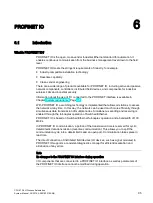
Operator controls and operating modes of the CPU 410-5H
7.1 Operating modes of the CPU 410-5H
CPU 410-5H Process Automation
104
System Manual, 09/2014, A5E31622160-AB
7.1.5
LINK-UP and UPDATE modes
The master CPU checks and updates the memory content of the standby CPU before the
fault-tolerant system assumes redundant system mode. This is implemented in two
successive phases: link-up and update.
The master CPU is always in RUN mode and the reserve CPU is in LINK-UP or UPDATE
mode during the link-up and update phases.
In addition to the link-up and update functions, which are carried out to establish redundant
system mode, the system also supports linking and updating in combination with
master/reserve changeover.
For detailed information on connect and updating, refer to section Link-up and update
(Page 121).
7.1.6
ERROR-SEARCH mode
The purpose of ERROR-SEARCH operating state is to find a faulty CPU. The standby CPU
runs the full self-test, while the master CPU remains in RUN. If a hardware fault is detected,
the CPU changes to DEFECTIVE state. If no fault is detected the CPU is linked up again.
The fault-tolerant system resumes the redundant system state. An automatic master-standby
changeover then takes place. This ensures that when the next error is detected in error-
search mode, the hardware of the previous master CPU is tested.
No communication is possible, e.g., by means of access from a programming device, while
the CPU is in ERROR-SEARCH operating state. The ERROR-SEARCH operating state is
indicated by the flashing RUN and STOP LEDs, see Chapter Status and error displays
(Page 41).
Note
If the master CPU changes to STOP during troubleshooting, the troubleshooting is continued
on the standby CPU. However, once troubleshooting is completed, the standby CPU does
not start up again.
The following events will trigger the ERROR-SEARCH operating state:
1.
If a one-sided call of OB 121 (on only one CPU) occurs in redundant operation, the CPU
assumes a hardware fault and switches to ERROR-SEARCH operating state. The other
CPU becomes master, if necessary, and continues running in solo operation.
2.
If a checksum error occurs on only one CPU in redundant operation, that CPU switches
to ERROR-SEARCH operating state. The other CPU becomes master, if necessary, and
continues running in solo operation.
3.
If a RAM/PIQ comparison error is detected in redundant operation, the standby CPU
switches to ERROR-SEARCH operating state (default response), and the master CPU
continues running in solo operation.
The response to RAM/PIQ comparison errors can be modified in the configuration (for
example, the standby CPU switches to STOP).














































